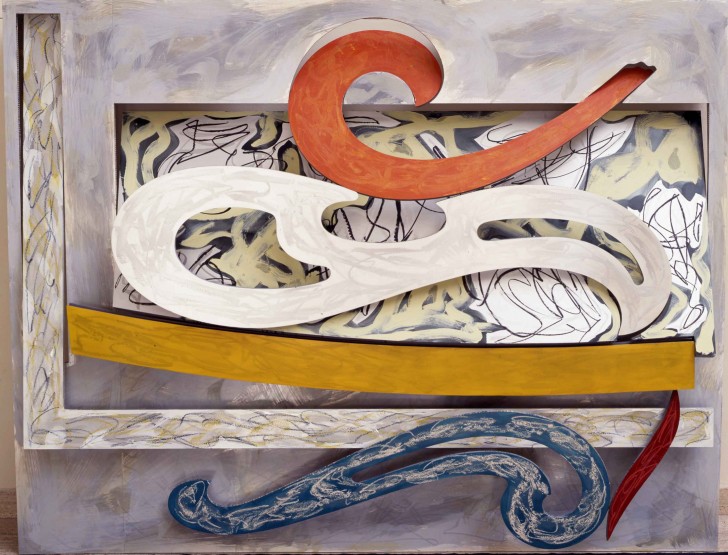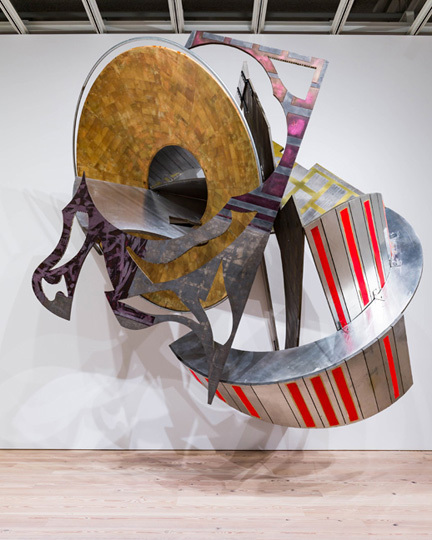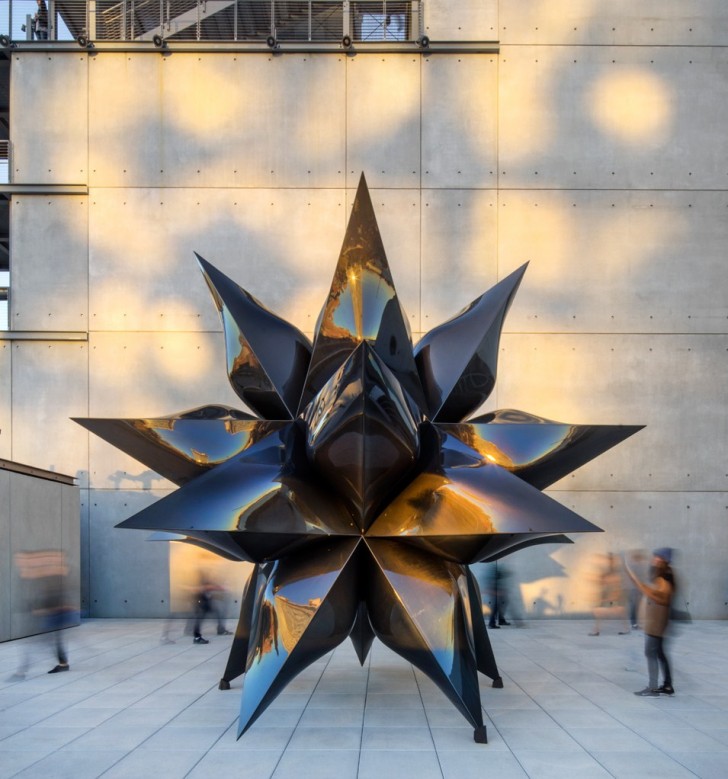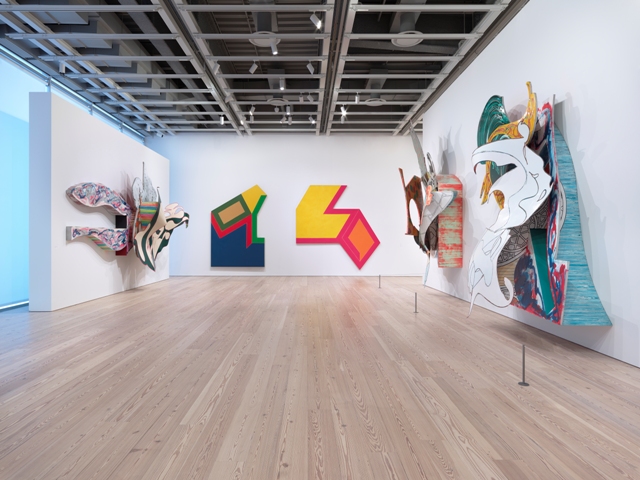“There are two problems in painting. One is to find out what painting is and the other is to find out how to make a painting.”
These words, the opening volley in a lecture Frank Stella delivered at Pratt Institute in 1960, have animated the artist’s practice for almost sixty years. Indeed, to look back over the arc of Stella’s career—from the dizzying heights he achieved with the Black Paintings through the challenges posed by the Irregular Polygons to his more recent monumental painted wall reliefs—is to see an artist who is constantly reimagining what painting could be, and, therefore, constantly relearning how to make paintings. And yet, within these seemingly limitless parameters, there is one thing that has never been open to debate: for Stella, who came of age when Abstract Expressionism ruled the New York art scene, painting has always been, and must always remain, abstract. This sacrosanct imperative made Stella the darling of the ’60s and ’70s, championed by formalist critics including Michael Fried and Clement Greenberg. Today, however, it can make his work feel cold and detached; this outdated “art for art’s sake” mentality distances him from the messy questions of agency, politics, and responsibility that have become increasingly important to artists since the rise of Postmodernism, and which have gained the same traction with painters in the twenty-first century as formalist concerns did during the 1960s.

This is not to say that Stella is not still enjoying a remarkably healthy career: 2015 has been, in some senses, yet another banner year for the seventy-nine-year-old artist. On November 4th, Sotheby’s established a new auction record of $13.7 million for Stella’s Delaware Crossing—a resolutely abstract, fire engine–red, nearly six-and-a-half-foot square painting created in 1961 as part of the Benjamin Moore series. And on October 30th, the artist’s most recent New York retrospective opened at the Whitney Museum of American Art, where nearly sixty years’ worth of Stella’s peregrinations through the field of abstract painting can be viewed through February 7th, 2016.
To see such divergent works as Die Fahnhoch! (1959), one of Stella’s breakthrough Black Paintings, Effingham II (1966), from the Irregular Polygons series, Gobba, zoppa e collotorto (1985), or Das Erdbeben in Chili [N#3] (1999) hung together in a single gallery space is both thought-provoking and disorienting. On the one hand, it demonstrates the continuity of Stella’s oeuvre, the extent to which the Black Paintings are the black holes of the artist’s universe, already containing each seed and all of the energy that will be released explosively in the later series. On the other hand, the exhibition reveals the limitations of Stella’s practice and his stubborn refusal to address any questions that lie beyond the reach of color, form, shape, and volume. Cool and at times, perhaps, even calculated, Stella has gone to great lengths to keep his art relevant while abstaining from participating in any of the current debates animating the art world such as social and political responsibility, the role of figuration, or the effects of globalization on artistic production. To attempt to understand the circuitous and at times insular conversation that has guided the artist’s practice—What is painting? And how do I make one?—one must explore how the conversation has evolved over the past six decades.
Frank Stella was born in Malden, Massachusetts and educated at the prestigious Phillips Academy in Andover, MA and Princeton University, where he befriended Michael Fried, who would later champion his work as a critic. Princeton’s proximity to New York City allowed Stella to immerse himself in the gallery scene. Exposure to the work of Jackson Pollock and the other Abstract Expressionists had a profound influence on his own art. As he told an interviewer in 2011, “I wouldn’t have bothered becoming an artist if I didn’t like the artists of that generation so much.” After graduating from Princeton, Stella moved to New York City in 1958, where he shared a studio with sculptor Carl Andre and photographer Hollis Frampton.

His breakthrough did not take long: in early 1958 Stella attended Jasper Johns’ debut solo show at Leo Castelli Gallery, where he was struck by the flatness and immediacy of Johns’ flag and target works. This catalyzed Stella’s move away from the gestural, authorial painting techniques favored by artists like Pollock, de Kooning, and Rothko, towards completely flat, symmetrical canvases that seemed devoid of any authorial influence. As the title of the series suggests, the Black Paintings, including Die Fahnhoch! [The Flag on High] and The Marriage of Reason and Squalor II, both from 1959, are black canvases, in which Stella has applied the paint following the uniform, flat process used by house painters. The paint is evenly divided by thin pinstripes of raw canvas that show through in symmetrical patterns determined by the width of the stretcher. Dorothy Miller included several of these canvases in her highly influential 1959 exhibition “Sixteen Americans” at the Museum of Modern Art, which also included work by Jasper Johns, Robert Rauschenberg, Louise Nevelson, and Jay DeFeo, among others; Stella’s reputation as a groundbreaking young artist was secured.
The evocative, even poetic, titles of the individual Black Paintings notwithstanding, Stella had apparently succeeded, in his first foray into professional artistic production, in reducing painting to its very essence, had created work that is as formal, as self-reflexive as possible. If one were to be unkind, one could view the rest of Stella’s career as an attempt to paint himself out of the absolute solution he had arrived at (before the age of twenty-five) to the questions: What is painting? And how do I make one?
Stella followed the success of the Black Paintings with more success by beginning to expand on the lexicon they had introduced: the Aluminum Paintings (begun 1960) introduced notches and cutouts into Stella’s repertoire; the Copper Paintings (begun 1960–61) extended these notches into the first shaped canvases in the artist’s oeuvre; while the Benjamin Moore series (begun 1961) reprised the format of the Black Paintings in the primary and secondary hues of red, green, yellow, blue, orange, and indigo. “What you see is what you see,” Stella said in 1964, avowing both the materiality of his work and his refusal to admit any deeper meaning beyond a viewer’s immediate visual perception. And it was these canvases that earned Stella a place at the vanguard of the Minimalist movement, although he never accepted his association with artists like Donald Judd and Dan Flavin and immediately began to move in a new direction.

Having mastered the flat, rectangular canvas, Stella began exploring the possibilities inherent in shaped canvases—an avenue of inquiry first touched upon in the Copper Paintings. In the Irregular Polygons (begun 1966), a series of forty-four monumental canvases, the L-, N-, and T-shapes of the Copper Paintings morph into a plethora of asymmetric forms: rectangles, squares, and rhomboids attached at odd angles to diamonds, triangles and other two-dimensional figures, covered in bright, flat hues that range from deep blues and greens to fluorescent shades of yellow, pink, and orange. “Frank Stella’s new paintings,” Michael Fried opined in the November 1966 volume of artforum, “investigate the viability of shape as such.… And by the viability of shape, I mean its power to hold, to stamp itself out, and in—as verisimilitude and narrative and symbolism used to impress themselves—compelling conviction.” With this series, Stella moved decisively away from the budding Minimalist movement, and while maintaining the flatness and utter abstractness of the canvas, began to explore the opportunities intrinsic to movement and space, shifting painting into sculpture’s tradition territory. Titled after cities in New Hampshire where the artist vacationed in his youth, the Irregular Polygons won Stella critical acclaim in the form of his first retrospective at the Museum of Modern Art—when he was only thirty-three years old. Whether or not they lived up to Fried’s rhetoric and conveyed the same “compelling conviction” as “verisimilitude and narrative and symbolism” seems now to be a moot point, considering how far from the formalist conception of art we now find ourselves in the post-Pop, Postmodern era.
The seeds of Stella’s expansionist—to use his word, “maximalist”—approach to art-making were already sown in the Irregular Polygons, and they began germinate in the series that followed: by the mid-1970s, the artist who had begun his career painting flat black canvases was working on a series of exuberantly painted aluminum wall reliefs—some even punctuated with streaks of glitter—entitled the Exotic Birds. And so it would seem that Stella once again found a new approach to painting, a new conception of what it would take to create great abstract art. Flatness and objectivity were now less important than how the work related to space: the space of the gallery and the space inhabited by the viewer.

Indeed, by the time Stella was asked to deliver the prestigious Norton Lectures at Harvard University in 1983–84, space, or “working space,” as he called it, had become the driving concern of the artist’s practice. In his series of six lectures, Stella traced the roots of abstract art to Caravaggio, and the spatial revolution that the Baroque artist initiated by creating pictorial spaces that interacted with the viewer’s space and broke down the boundaries between these two realms while maintaining equilibrium between the importance of both the artist’s and the viewer’s points of view: “Caravaggio’s advantage comes from his ability to create the sensation of real space within and outside of the action of the painting, powerfully reinforcing his masterful illusionism.” And so, just as Caravaggio’s Saint Matthew projected a powerful presence into the space its chapel, Stella made his works literally undulate, moving them off of the wall in planes of cantilevered, painted aluminum that intrude into their viewers’ physical space. But unlike Caravaggio’s spaces, which are alive and pulsating with visceral emotions that convey potent Counter Reformation ideals and into which seventeenth-century viewers could easily transport themselves emotionally and physically, Stella’s forms—regardless of their virtuosity and grandeur—remain cold, emotionless, and unrelatable. Encountering one of Stella’s “paintings” from this period—works such as St. Michael’s Counterguard (1984) or Gobba, zoppa e collotorto (1985)—is at once confrontational and perplexing. As Peter Schjeldahl points out in his review of the Whitney exhibition, while in Caravaggio’s work, the “story told and the manner of its telling conjoin,” the effect of Stella’s protruding, contorted assemblages of shapes is like “very loud music that has neither tune nor tone.”
Much of the Whitney’s retrospective is given over to these large painting-sculpture hybrids, highlighting just how much of Stella’s career has been spent constructing them, and how little critical attention they have received compared to his earlier works. And they remain largely impenetrable: seeing so many of these behemoth works, including the Moby Dick series (begun 1986) and his more recent, almost purely sculptural works such as K.144 (2013) in one space created many opportunities for ogling and guessing at the intricate nature of their fabrication, but it did little to foster any kind of prolonged looking or thinking. In fact, constantly glimpsing these projections around gallery walls seemed to preclude any notion of deep engagement—they were like so many arcade games, constantly beckoning to the hopeful, but never dispensing any prizes.

And yet, regardless of the difficulties they pose to the viewer, the continued fecundity Frank Stella has found in the exploration of his constantly evolving conception of what painting is and how to create it is mesmerizing. To suggest that Stella has ever created work with a blind eye to how it will be received would be foolish, for Stella is nothing if not ambitious and competitive; however, to view the Whitney retrospective is to experience an intensely personal conversation between Stella and his own principles. Determined to open up “working space” for painting, he has constantly pushed the limits of the medium for decades, but somehow he is blind to the constrictions he has placed on himself and on the evocative potential of his own art by his adherence to an outdated formalist doctrine.
To look at the course of Stella’s career, to go to the Whitney and to walk from the Black Painting through the Irregular Polygons, to pause in front of the magisterial Damascus Gate (Stretch Variation III) (1970), and to wander among the twisting, jutting, attention-grabbing wall reliefs is to see a working practice evolve over decades, is to see an artist who—whether we enjoy the outcome or not—is constantly grappling with the questions that are central to his craft. Had Pollock lived to be eighty, what would his work have looked like? What would Caravaggio’s, for that matter, had he not died while still in his thirties? Would these artists have evolved and adapted? Would they have continued to find new ways to explore issues central to their art? Or would they have slipped into a formulaic stasis, clinging to the style that brought them a taste of fame, too afraid to push beyond the applause? As Stella told his audience at Harvard in 1983, “Painting does not want to be confined by boundaries of edge and surface.” And nor does these paintings’ creator.
